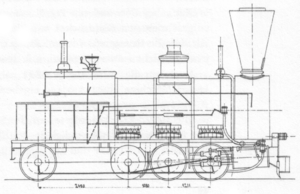SStB - Vindobona
| SStB - Vindobona | |
|---|---|
|
SStB - Vindobona before the renovation
|
|
| Numbering: | SB 899 |
| Number: | 1 |
| Manufacturer: | WRB |
| Year of construction (s): | 1851 |
| Axis formula : | D n2 (C2 'n2) |
| Gauge : | 1435 mm ( standard gauge ) |
| Fixed wheelbase: | 4,741 mm (2,291 mm) |
| Total wheelbase: | 4,741 mm (n / a) |
| Service mass: | 47.2 t |
| Friction mass: | 47.2 t |
| Driving wheel diameter: | 948 mm |
| Number of cylinders: | 2 |
| Cylinder diameter: | 448 mm |
| Piston stroke: | 579 mm |
| Boiler overpressure: | 8.5 atm |
| Number of heating pipes: | 286 |
| Heating pipe length: | 3,372 mm |
| Grate area: | 1.59 m² |
| Tubular heating surface: | 176.2 m² |
The steam locomotive "VINDOBONA" was a freight locomotive of the Imperial and Royal Southern State Railways . It was built on the occasion of the Semmering competition in 1851 by the locomotive factory of the Vienna-Raaber Bahn in Vienna . The other three locomotives that took part in this competition for the right locomotive for the Semmering Railway were the " BAVARIA ", the " SERAING " and the " NEUSTADT ".
The "VINDOBONA" was initially built with the C axis configuration . However, when it turned out during the weighing process that the load on the front axle exceeded the value prescribed for the competition, another one was installed between the first two axles. The last pair of wheels was behind the fire box.
In the performance tests in the course of the competition, the "VINDOBONA" fulfilled all the prescribed performance parameters, but was the weakest of the four machines. It was therefore only awarded fourth place and it was bought by the state for 8,000 ducats.
Despite this poor performance, the innovations implemented in this machine for the first time by its designer John Haswell were groundbreaking and exemplary for the mountain locomotives that followed. For example, Haswell used the fact that when a locomotive is idling, when the controls are turned in the opposite direction, air is drawn in and compressed as a brake . The later Riggenbach counter-pressure brake is an improvement on this forgotten invention of Haswell.
In the case of the "VINDOBONA", the bar anchors that were attached to earlier locomotives to stiffen the inner fire box ceiling had been replaced by screws. This construction was later widely used under the name Belpairsche Feuerbüchse.
When it turned out that the "VINDOBONA" had a destructive effect on heavily curved tracks due to its long, fixed axle base, Haswell replaced the last axle with a two-axle bogie, which, however, was not rotatable around a pivot between the bogie axles, as was customary before equipped with a drawbar, had moved its pivot point far forward. Apart from the reset device, this bogie is identical to the Bissel frame patented in America in 1857 .
During this renovation, Haswell also made a change to the boiler. The steam room turned out to be too small to deliver dry steam. Haswell placed two more domes on the fire box and on the long boiler behind the chimney, which he connected to the existing dome with a wide pipe. As a result, the steam space was significantly enlarged and the steam did not have to brush the water level in order to get to the regulator, which meant that it could not pull in additional water. Later almost all Austrian locomotive series were built with this or a similar arrangement of the domes.
Even after these modifications, the "VINDOBONA" was not suitable for operation on Semmering . The too small wheels, the oval cross-section of the boiler and the insufficient adhesive weight ultimately led to the machine being dismantled. Your boiler was used as a stationary boiler in the Ljubljana workshop for several years .
literature
- Herbert Dietrich: The southern railway and its predecessors , Bohmann Verlag, Vienna, 1994, ISBN 3-7002-0871-5
- Karl Gölsdorf : Locomotive construction in old Austria 1837-1918 , Slezak publishing house , 1978, ISBN 3-900134-40-5


